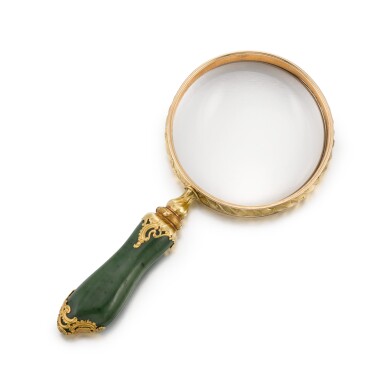Russian Works of Art, Fabergé and Icons
Russian Works of Art, Fabergé and Icons

Property from a Private Collection, Denmark
A Fabergé gold-mounted nephrite magnifying glass, workmaster Michael Perkhin, St Petersburg, circa 1890
Auction Closed
November 30, 06:31 PM GMT
Estimate
15,000 - 25,000 GBP
Lot Details
Description
Property from a Private Collection, Denmark
A Fabergé gold-mounted nephrite magnifying glass, workmaster Michael Perkhin, St Petersburg, circa 1890
of typical form, the side of the gold mount cast and chased and engraved with a foliate pattern, the edges reeded, the shaped nephrite handle applied with gold rocaille foliate scrolls and rosettes, struck throughout with workmaster’s initials and Fabergé in Cyrillic, 56 standard, scratched inventory number 50751
18.2cm; 7 3/16 in.
Perkhin is the Chief Workmaster associated with Fabergé's emphasis on the application of Neo-Classical, Rococo and Louis XVI style to modern day objects and utilitarian items such as cigarette cases and compacts, ashtrays, bell pushes, lorgnettes, magnifying glasses and ink bottles ‘in place of decorative objects with no earthly purpose’ (Franz Birbaum as quoted in T. and S. Fabergé, History of the Fabergé firm: According to the recollections of the Head Designer of the Firm Franz P. Birbaum, St Petersburg, published privately, 1992, p. 5).
Fabergé’s mission was complemented by the era of prosperity in which Russia found itself at the turn of the century. From the end of the nineteenth century onwards, Fabergé’s clients sought ‘an almost endless array of objets de luxe’ (G. Hill et al., Fabergé and the Russian Master Goldsmiths, New York, 1989, p. 290), items such as the present magnifying glass which showcased both their wealth and how fashionable they were.
This magnifying glass exemplifies both this period of great pioneering in Fabergé's history and also a style characteristic of Perkhin, embodied by the piece's gold rococo flourishes.
